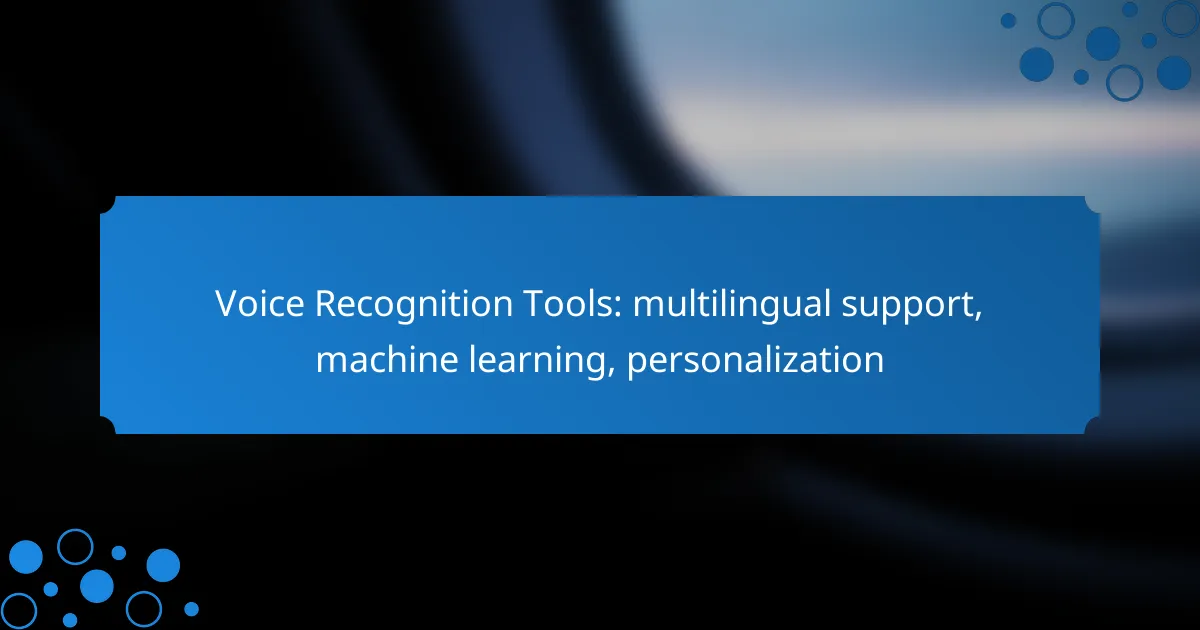Voice recognition tools have evolved to offer robust multilingual support, making them essential for diverse users in Canada. Utilizing advanced machine learning algorithms, these tools not only transcribe speech accurately across various languages but also adapt to individual accents and preferences. Personalization features further enhance user experience by creating tailored voice profiles that improve recognition and contextual understanding over time.
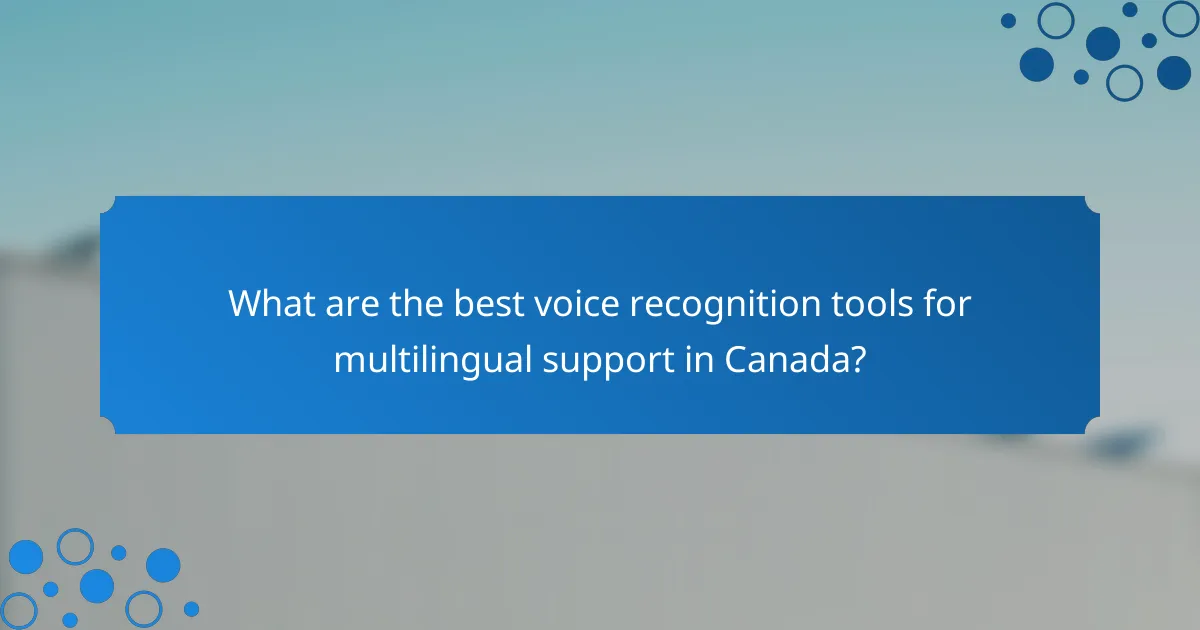
What are the best voice recognition tools for multilingual support in Canada?
The best voice recognition tools for multilingual support in Canada include Google Cloud Speech-to-Text, IBM Watson Speech to Text, and Microsoft Azure Speech Service. These platforms leverage advanced machine learning algorithms to accurately transcribe and understand multiple languages, catering to the diverse linguistic needs of Canadian users.
Google Cloud Speech-to-Text
Google Cloud Speech-to-Text offers robust multilingual support, recognizing over 120 languages and variants. It utilizes deep learning models to enhance accuracy and can process audio in real-time or from pre-recorded files, making it versatile for various applications.
When using this tool, consider its integration capabilities with other Google services, which can streamline workflows. However, be mindful of potential costs, as pricing is based on usage, which can add up with extensive use.
IBM Watson Speech to Text
IBM Watson Speech to Text is designed for enterprise-level applications, providing support for multiple languages and dialects. Its machine learning capabilities allow it to adapt to specific vocabularies and accents, improving transcription accuracy over time.
This tool is particularly useful for businesses needing to analyze customer interactions or transcribe meetings. However, users should be aware of the complexity in setup and the need for a solid understanding of its API for optimal use.
Microsoft Azure Speech Service
Microsoft Azure Speech Service supports numerous languages and dialects, making it a strong contender for multilingual applications. It offers features like speech synthesis and translation, which can enhance user experience in diverse environments.
For Canadian users, the service is compliant with local data regulations, ensuring that sensitive information is handled appropriately. However, users should evaluate the pricing model, as it can vary based on the features utilized and the volume of audio processed.
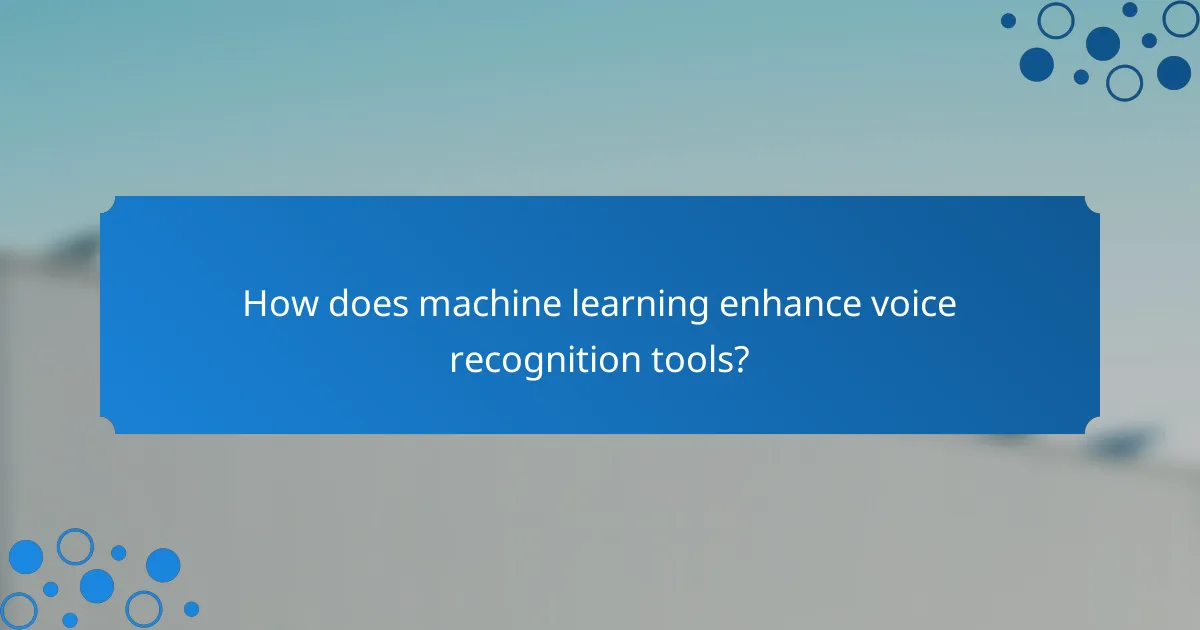
How does machine learning enhance voice recognition tools?
Machine learning significantly improves voice recognition tools by enabling them to learn from data and adapt to various languages and accents. This technology enhances the system’s ability to understand and process speech more accurately over time.
Improved accuracy through training
Machine learning algorithms enhance accuracy by training on large datasets of spoken language. These datasets often include diverse accents, dialects, and speech patterns, allowing the system to recognize and interpret a wide range of voices. As more data is processed, the algorithms refine their models, leading to better performance in real-world applications.
For instance, a voice recognition tool trained on thousands of hours of audio can achieve accuracy rates exceeding 90%. Regular updates with new data help maintain and improve this accuracy, especially as language evolves.
Adaptive learning for user preferences
Adaptive learning allows voice recognition tools to personalize their responses based on individual user preferences. By analyzing a user’s speech patterns and commands, the system can adjust its recognition algorithms to better suit that specific user. This leads to a more intuitive and efficient interaction.
For example, if a user frequently uses certain phrases or commands, the system can prioritize these in its recognition process. This customization can significantly enhance user experience, making interactions smoother and more effective.
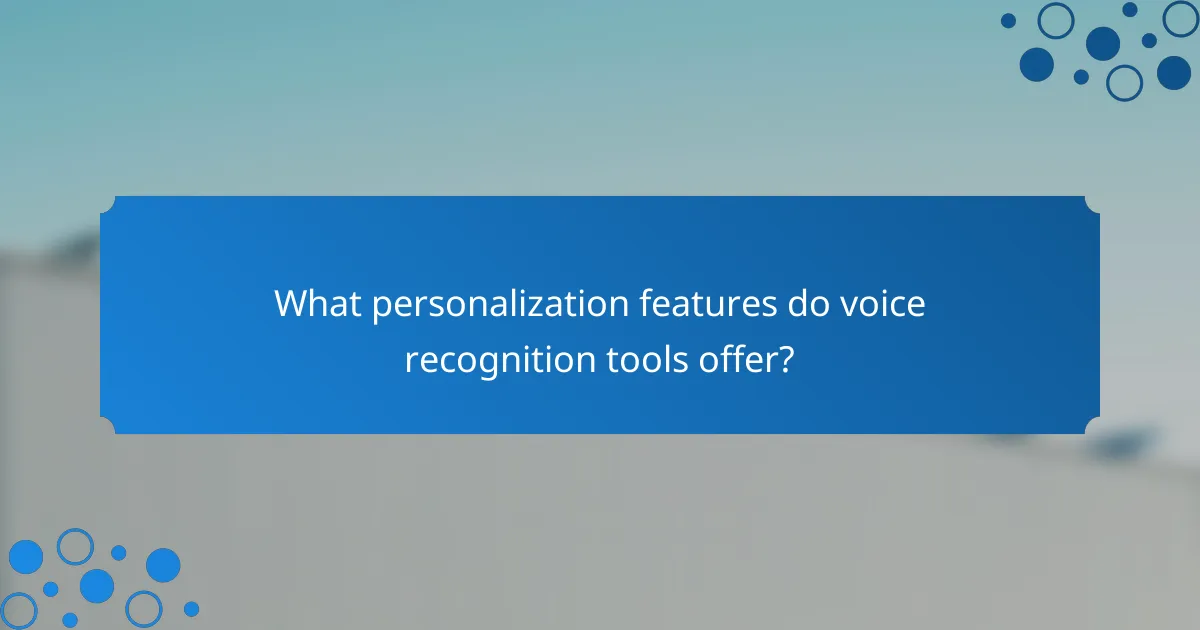
What personalization features do voice recognition tools offer?
Voice recognition tools provide various personalization features that enhance user experience by adapting to individual preferences and speech patterns. These features include user-specific voice profiles and contextual understanding based on usage, allowing the technology to recognize and respond more accurately to each user.
User-specific voice profiles
User-specific voice profiles enable voice recognition systems to learn and adapt to the unique vocal characteristics of individual users. This includes variations in tone, accent, and speech patterns, which helps improve accuracy in voice commands and responses. For example, a tool may store a user’s voice data to differentiate between multiple speakers in a household.
Creating a voice profile typically involves a short training session where the user reads predefined phrases. This process can take just a few minutes, but it significantly enhances the system’s ability to understand commands and queries from that specific user.
Contextual understanding based on usage
Contextual understanding allows voice recognition tools to interpret commands based on previous interactions and situational context. This means that the system can adjust its responses based on the user’s habits, preferences, and even the time of day. For instance, a voice assistant might suggest a morning playlist when it recognizes that the user typically listens to music during breakfast.
To maximize the effectiveness of contextual understanding, users should regularly interact with the tool and provide feedback on its responses. This ongoing interaction helps the system refine its understanding and improve its ability to anticipate user needs, making it more intuitive over time.
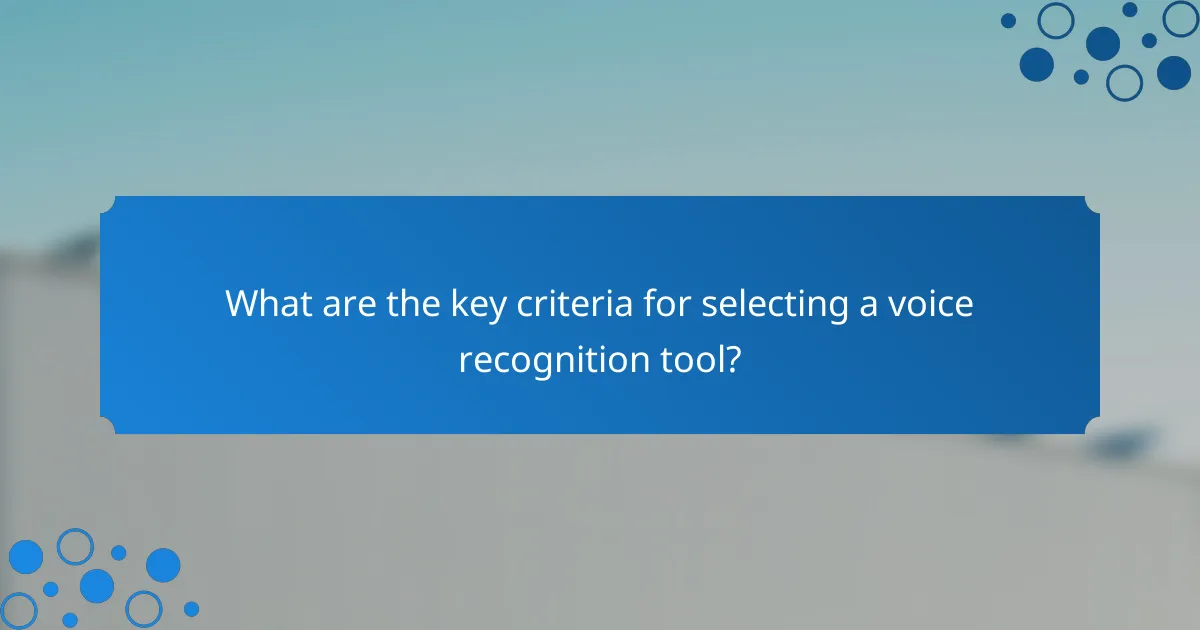
What are the key criteria for selecting a voice recognition tool?
When selecting a voice recognition tool, consider factors such as language support, accuracy, and integration capabilities. These criteria will help ensure the tool meets your specific needs and works effectively within your existing systems.
Language support and accuracy
Language support is crucial for voice recognition tools, especially in multilingual environments. Look for tools that can accurately recognize and process multiple languages, dialects, and accents. Accuracy rates can vary significantly, so prioritize tools that demonstrate high performance across the languages you require.
Consider testing the tool with sample phrases in different languages to evaluate its effectiveness. A good benchmark for accuracy is around 90% or higher in real-world applications, but this may vary based on the complexity of the language and context.
Integration capabilities with existing systems
Integration capabilities determine how well a voice recognition tool can work with your current software and hardware. Ensure the tool can easily connect with existing applications, such as CRM systems or customer service platforms, to streamline workflows and enhance user experience.
Evaluate the availability of APIs and SDKs that facilitate integration. Tools that offer robust support for popular programming languages and platforms will typically provide a smoother implementation process. Additionally, check for compatibility with cloud services or on-premises solutions based on your organization’s infrastructure preferences.
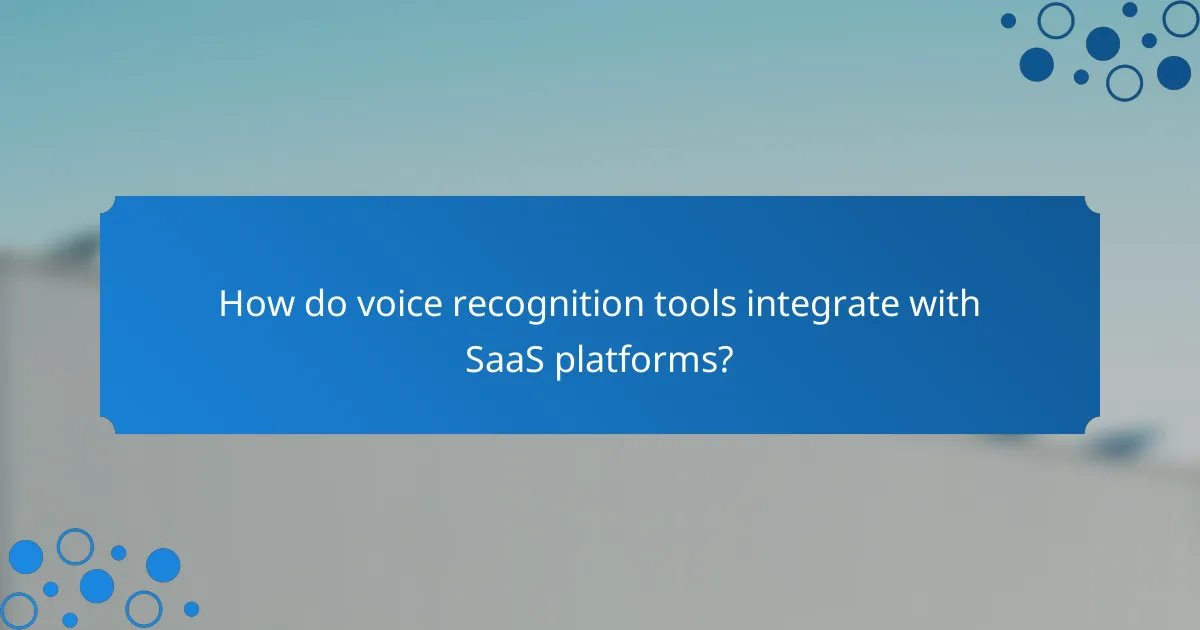
How do voice recognition tools integrate with SaaS platforms?
Voice recognition tools integrate with SaaS platforms by utilizing APIs that allow for real-time processing and data exchange. This integration enhances user experience by enabling voice commands and dictation features within various applications.
API access for seamless integration
API access is crucial for integrating voice recognition tools with SaaS platforms, as it facilitates the connection between the voice recognition service and the application. Developers can leverage RESTful APIs to send audio data and receive transcriptions or commands in return, ensuring a smooth workflow.
When choosing a voice recognition API, consider factors such as response time, accuracy, and supported languages. Popular options include Google Cloud Speech-to-Text and Microsoft Azure Speech Service, both of which offer robust documentation and support for various programming languages.
Compatibility with popular SaaS applications
Voice recognition tools are increasingly compatible with popular SaaS applications, enhancing their functionality. For instance, tools like Zoom and Slack have integrated voice recognition features that allow users to transcribe meetings or send voice messages effortlessly.
When integrating voice recognition into a SaaS application, ensure that it aligns with the application’s existing features and user interface. Testing for compatibility with different devices and operating systems is essential to provide a consistent user experience across platforms.
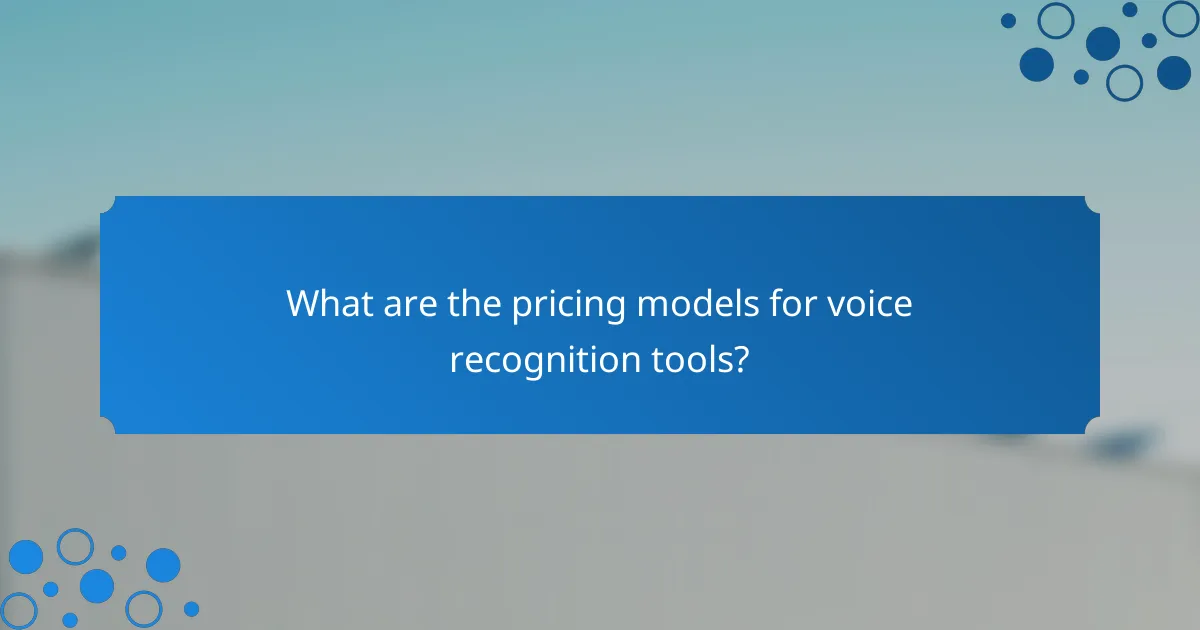
What are the pricing models for voice recognition tools?
Voice recognition tools typically offer various pricing models, including subscription-based plans and pay-as-you-go options. Each model has its advantages and considerations, depending on usage frequency and specific needs.
Subscription-based pricing
Subscription-based pricing involves paying a recurring fee, often monthly or annually, for access to voice recognition services. This model is ideal for businesses or individuals who require consistent usage, as it usually provides unlimited or high-volume access at a lower cost per use.
Common subscription tiers may vary based on features such as the number of languages supported, API access, or additional functionalities like analytics. For example, a basic plan might start around $10 to $30 per month, while premium plans can exceed $100, depending on the service provider.
Pay-as-you-go options
Pay-as-you-go options allow users to pay only for the services they actually use, making it a flexible choice for those with variable needs. This model is beneficial for occasional users or projects with uncertain demand, as it avoids upfront commitments.
Pricing in this model is typically based on usage metrics, such as the number of minutes processed or the volume of API calls. Rates can range from a few cents to several dollars per minute, depending on the complexity of the recognition tasks and the provider’s pricing structure.

What are the emerging trends in voice recognition technology?
Emerging trends in voice recognition technology include enhanced multilingual support, a strong emphasis on privacy and data security, and significant advancements in natural language processing. These developments are shaping how users interact with devices and services, making voice recognition more accessible and secure.
Increased focus on privacy and data security
As voice recognition technology becomes more prevalent, there is a growing emphasis on protecting user data and ensuring privacy. Companies are implementing stricter data handling protocols and encryption methods to safeguard voice data from unauthorized access.
Users should be aware of privacy settings when using voice recognition tools. Opting for services that offer transparent data policies and allow users to manage their data can help mitigate privacy risks. Look for features that let you delete voice recordings or opt-out of data sharing.
Advancements in natural language processing
Natural language processing (NLP) is rapidly evolving, enhancing the ability of voice recognition systems to understand and respond to diverse languages and dialects. Improvements in machine learning algorithms enable these systems to recognize context, tone, and intent more accurately.
For practical use, this means that voice recognition tools can now handle complex queries and provide more personalized responses. Users can expect better performance in multilingual environments, making it easier to interact with devices in their preferred language without compromising accuracy.
